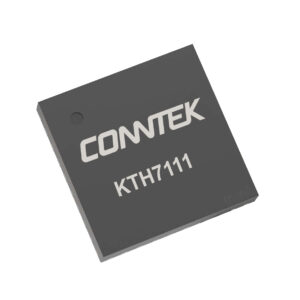The KTH7801 is a high-precision absolute angle Hall sensor chip offering up to 16-bit resolution for accurate angle measurements in both on-axis and off-axis configurations. Capable of handling rotational speeds ranging from 0 to 120,000 rpm, the KTH7801 ensures rapid and precise angle output, making it a robust choice for applications requiring accurate angle measurement and speed control.
The KTH7801 provides multiple flexible angle output modes to meet diverse application needs. First, it supports a programmable ABZ quadrature pulse output with up to 4096 steps per revolution, delivering high-resolution position data. Additionally, the 4-wire SPI interface facilitates efficient angle reading and device communication. The KTH7801 also supports a 2-wire SSI output, simplifying system design and integration.
To further enhance its practical application, the KTH7801 features built-in magnetic field strength detection. Users can program high and low magnetic field thresholds, enabling real-time monitoring and adjustment. This functionality helps to select the optimal magnet and determine the appropriate installation setup, ensuring stable operation. Moreover, the KTH7801 incorporates Memory-Programmable Technology (MPT) to store critical configuration parameters. Users can save settings such as the zero-angle position, ABZ encoder configurations, and magnetic field detection thresholds, allowing for adaptable performance across various operational environments.
In summary, the KTH7801 is engineered to provide versatility, accuracy, and adaptability, making it a reliable solution for a wide range of angle measurement and control applications.
The KTH7801 is a Hall angle encoder that integrates Hall elements, analog-to-digital converters (ADC), and various modules for precise angle measurement and digital signal output. The Hall element in the encoder generates voltage signals, which are converted into two orthogonal digital signals through the ADC. These signals are then processed by the ATAN module to obtain a 16-bit digital angle. The digital angle is further adjusted through zero-point setting, rotation direction setting, and filtering.
The encoder’s output interface can directly provide the filtered angle data through SPI and SSI communication, allowing the user to read it directly using an MCU or other circuits. Additionally, the angle can also be represented through PWM modulation, with the angle value reflected by the duty cycle. To enhance the update rate, the filtered angle can be further processed by an interpolator and output to the ABZ angle encoder module, converting the angle into the desired encoded signal.
Moreover, various operating parameters of the system are stored in a multi-time programmable (MTP) memory, which can be modified through SPI commands to meet different application requirements.
| Part number | KTH7101 | KTH7111 | KTH7112 | KTH7801 |
| Absolute Resolution | 16 bit | 16 bit | 16 bit | 16 bit |
| On-axis topology | x | – | x | x |
| Off-axis topology | x | x | – | x |
| Multi-pole topology | x | x | x | x |
| ANCL automatic non-linear calibration | on- & off-axis | off-axis | on-axis | – |
| INL error (after calibration) | ±0,1◦ (on-axis) ±0,2◦ (off-axis) |
±0,2◦ | ±0,1◦ | ±0,35◦ |
| Magnetic field strength diagnosis / alarm | – | – | – | x |
| Magnetic stray field compensation | x | – | – | – |
| Latency (data update) | 1 μs | 1 μs | 1 μs | 1 μs |
| SPI (communication + angle) | 10 Mbps | 10 Mbps | 10 Mbps | x |
| CRC available | – | – | – | x |
| SSI (angle) | – | 5 Mbps | 5 Mbps | x |
| ABZ incremental resolution | 4 … 16384 | 4 … 16384 | 4 … 16384 | 4 …4096 |
| PWM (angle) | – | 12 bit | 12 bit | 14 bit |
| PWM (calibatrion status) | – | x | x | – |
| UVW commutation signal | – | 1 .. 32 poles | 1 .. 32 poles | – |
| MTP multi-time programmable memory | x | x | x | x |
| Operating voltage | 3,3 … 5 V | 3,3 … 5 V | 3,3 … 5 V | 3,3 … 5 V |
| Operating temperature | −40◦C to 125◦C | −40◦C to 125◦C | −40◦C to 125◦C | −40◦C to 125◦C |
| AEC-Q100 automotive qualified | x | – | – | x |
| Package | QFN16 3×3 SOP-8 5×6 |
QFN16 3×3 | QFN16 3×3 | QFN16 3×3 SOP-8 5×6 |
| Model | Package | Pin Count |
Interfaces | CRC Check |
Operating Temperature |
| KTH7801-X-N-QN16 | QFN3x3-16L | 16 | SPI, SSI, ABZ, PWM |
no | -40°C – 125°C |
| KTH7801-X-N-SOP8 | SOP-8 | 8 | SPI, PWM | no | -40°C – 125°C |
| KTH7801-X-C-QN16 | QFN3x3-16L | 16 | SPI, SSI, ABZ, PWM |
yes | -40°C – 125°C |
| KTH7801-X-C-SOP8 | SOP-8 | 8 | SPI, PWM | yes | -40°C – 125°C |

Evaluation Kit for KTH7801

Hall Magnetic Encoder IC, 16-bit, on-axis, ABZ/UVW/PWM/SPI/SSI, ANLC auto non-linear calibration

Hall Magnetic Encoder IC, 16-bit, off-axis, ABZ/UVW/PWM/SPI/SSI, ANLC auto non-linear calibration

TMR Magnetic Encoder IC, 24bit, on- & off-axis, ABZ/UVW/PWM/SPI, ANLC auto non-linear calibration